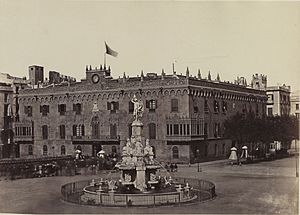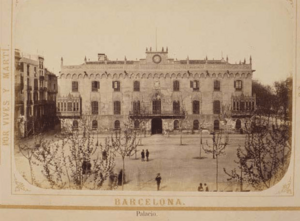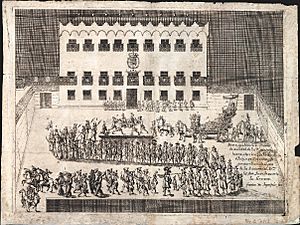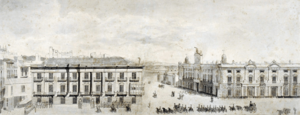Palace of the Viceroy (Barcelona) facts for kids
The Palace of the Viceroy (Catalan: Palau del Virrei, Spanish: Palacio del Virrey) was a large building in Barcelona, Catalonia, Spain. For some time, it was known as the Royal Palace (Catalan: Palau Reial, Spanish: Palacio Real)). People also called it Hala dels Draps, which means "Hall of the Cloths" in Catalan. It was located in the Pla de Palau, right in the middle of Barcelona's old town, the Ciutat Vella district.
This important building started out as a warehouse for wool in the Middle Ages. Later, in 1652, it was turned into a grand palace. It became the official home for the viceroys of Catalonia. A viceroy was like a governor who ruled a region in the name of the king. In 1844, it became the Royal Palace and a home for the Spanish Royal Family when they visited Barcelona. Sadly, a big fire destroyed the palace in 1875.
Contents
History of the Palace
From Warehouse to Palace
The story of the palace began in 1314 with a building called the 'Porxo del Forment'. This was a warehouse used to store wheat. Right next to it, a market for selling cloth was built in 1389. This market was also known as the 'Hala dels Draps'.
In 1514, these two buildings were joined together. An extra floor was added, and the combined building was used as an arsenal, a place to store weapons.
The Viceroy's Home
In 1652, King Philip IV took over the building. He decided it would be the new home for the Viceroy of Catalonia. The viceroy, also called the Lieutenant, was the king's representative in Catalonia. They moved from their old home, the Palau del Lloctinent.
Between 1668 and 1688, a new palace was built on the site. This was ordered by Viceroy Vicente Gonzaga Doria. The architect was a friar named Josep de la Concepció. He designed a beautiful baroque style building.
The palace had a square shape with a courtyard in the middle. It had three levels with balconies. The front of the building had some older Gothic style features. Inside, the most impressive room was the main hall, called the Sala de Festes. It was a large rectangular room that was two floors high.
In 1700, Viceroy Prince George of Hesse-Darmstadt had a special connection built. This connected the palace directly to the Santa Maria del Mar church.
During the War of the Spanish Succession, an important event happened here. In 1705, Archduke Charles of Habsburg was declared king of Spain inside the palace. Three years later, in 1708, he married Elisabeth Christine of Brunswick-Wolfenbüttel in the Santa Maria del Mar church. They lived in the palace until 1711, when they left for Vienna in Austria.
After the Nueva Planta decrees were put in place, the job of the viceroy was ended. The palace then became the home of the Captain General of Catalonia. This person was the main military and political leader of the region.
In 1771, the palace got a new look for its front. It was redesigned in a neoclassical style by the architect Juan Miguel de Roncali.
A Royal Residence
The palace became the official royal palace in 1844. This happened when the Captain General moved his home to a former convent. During this time, the palace was rebuilt in a neo-gothic style. The Spanish Royal family stayed in this palace whenever they visited Barcelona.
During the First Spanish Republic, which was a time when Spain was a republic, the palace was used as a court.
Sadly, a big fire destroyed the palace in 1875. It was never rebuilt after that.
It took a long time for Barcelona to get a new royal residence. In 1919, the Palau Reial de Pedralbes was built. Today, the current royal residence in Barcelona is the Palace of Albéniz. It is located in the Joan Maragall Gardens on the Montjuïc mountain. This palace was designed for the 1929 International Exposition.
See also
 In Spanish: Palacio del Virrey (Barcelona) para niños
In Spanish: Palacio del Virrey (Barcelona) para niños
- List of missing landmarks in Spain





